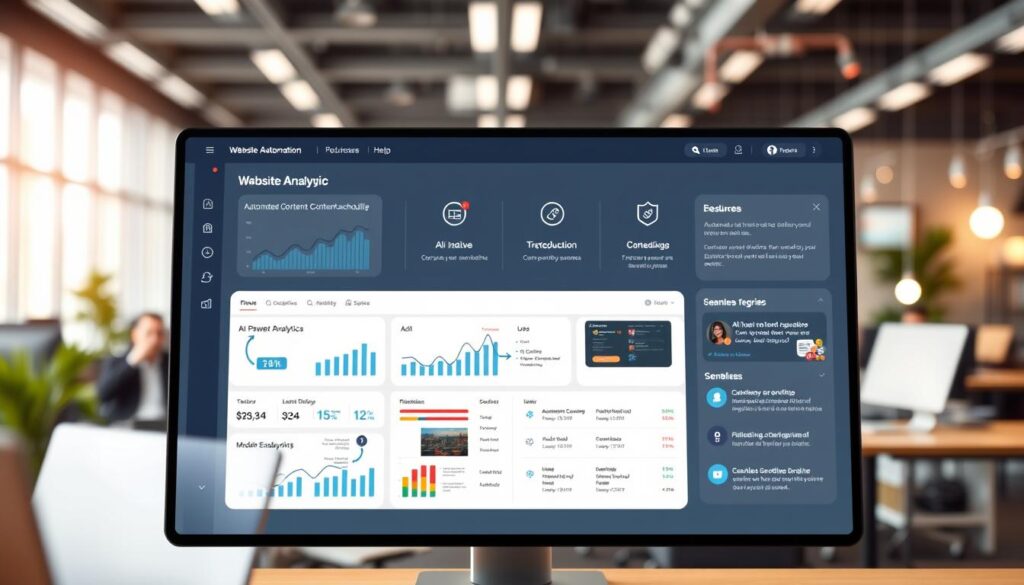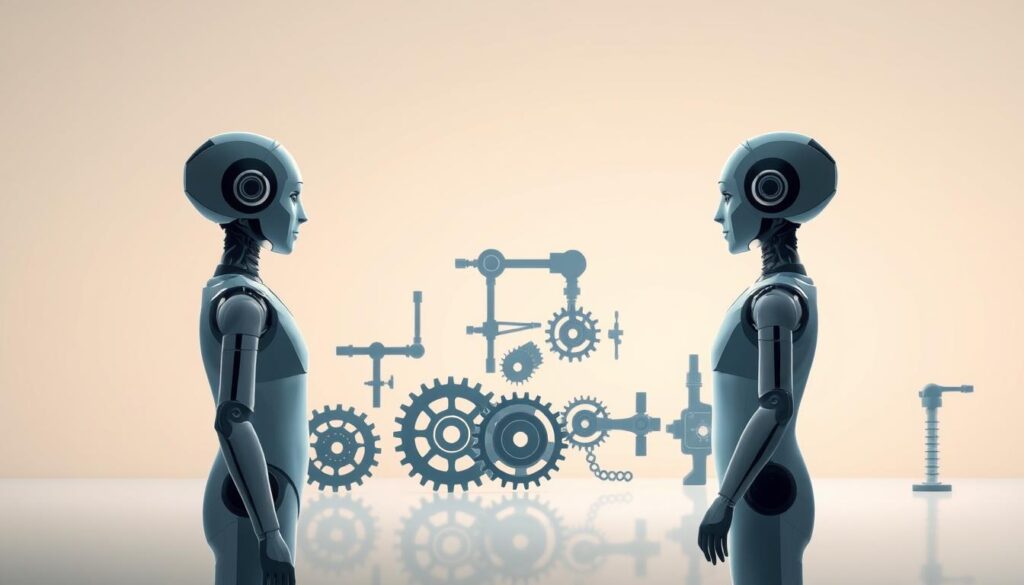What if your website could anticipate user needs before they even click? This isn’t science fiction—it’s the reality reshaping digital experiences today. Advanced tools now analyze behavior, adapt to preferences, and execute tasks with precision once reserved for human teams. But how do these systems achieve such responsiveness?
Recent data reveals a surge in adoption. Over 10% of large enterprises already deploy these solutions, with 52% planning integration within a year. Forrester Research identifies them as a top emerging technology for 2024, praising their ability to merge natural language processing and machine learning. Unlike rigid script-based approaches, they evolve through real-time interactions.
These agents excel in complex web environments. They process visual elements, interpret unstructured data, and make contextual decisions autonomously. One retail giant reduced customer service costs by 40% after implementation, according to Capgemini’s survey. The shift from reactive workflows to proactive problem-solving marks a new era in automation.
Key Takeaways
- Enterprise adoption rates have doubled since 2023
- Combines NLP, computer vision, and adaptive learning
- Reduces operational costs by up to 40% in case studies
- Replaces static workflows with dynamic decision-making
- Prioritizes real-time user intent analysis
Introduction: The Rise of AI in Website Development

Digital workflows have evolved dramatically since the early days of rigid, code-dependent systems. Where legacy tools stumbled with unpredictable scenarios, modern solutions now demonstrate contextual awareness through machine learning and pattern recognition. This shift mirrors broader technological innovation across industries, transforming how organizations approach advanced automation tools.
Traditional systems required manual updates for every new task—a process costing enterprises $4.7 million annually according to McKinsey research. Modern platforms overcome these limitations through adaptive algorithms that analyze user behavior. They handle multi-step processes like dynamic form completion and real-time content personalization without predefined rules.
| Features | Traditional Tools | Modern Solutions |
|---|---|---|
| Learning Ability | None | Continuous improvement |
| Task Complexity | Single-step | Multi-process workflows |
| Maintenance Needs | Weekly updates | Self-optimizing |
| Error Rate | 12-18% | <3% |
Three core advancements drive this transformation:
- Natural language processing interprets ambiguous requests
- Visual recognition analyzes interface elements
- Predictive modeling anticipates user needs
Early adopters report 63% faster task completion rates compared to script-based methods. As cognitive capabilities expand, these systems increasingly manage critical business operations—from inventory management to compliance checks—with minimal oversight.
Exploring AI agents for websites

The landscape of web automation is undergoing a paradigm shift with intelligent systems that independently manage digital operations. Unlike conventional tools requiring explicit instructions, these solutions analyze interface elements through visual recognition and contextual cues.
Modern platforms demonstrate three core competencies:
- Dynamic interpretation of unstructured website components
- Continuous strategy optimization through interaction history
- Parallel execution of diverse processes across platforms
“Autonomous systems reduce configuration demands by 78% compared to script-based alternatives,” notes a recent Gartner analysis of enterprise automation trends.
| Features | Legacy Systems | Modern Solutions |
|---|---|---|
| Decision Framework | Rule-based | Context-aware |
| Adaptation Speed | Manual updates | Real-time adjustments |
| Process Scalability | Single workflow | Cross-platform coordination |
| Learning Mechanism | Static | Reinforcement-based |
Leading organizations now deploy these tools for complex workflows like multi-channel data synchronization. A recent comparison of top-performing agents revealed 92% accuracy in handling unpredictable website modifications.
Advanced architectures enable simultaneous management of payment processing, inventory updates, and compliance checks. This multi-layered approach eliminates bottlenecks while maintaining audit trails for regulatory requirements.
Understanding the Technology Behind AI Web Agents

Modern web automation relies on interconnected systems that process both text and visuals. These tools combine linguistic analysis with visual recognition to interpret dynamic interfaces. Their ability to adapt stems from three core components working in tandem.
Large Language Models and Natural Language Processing
Large language models form the cognitive backbone, decoding complex instructions across websites. They analyze user requests, translate them into actionable steps, and generate responses aligned with objectives. Natural language processing extracts critical information from forms, chat logs, and documentation, enabling precise interactions.
Computer Vision and Context Awareness
Visual recognition systems identify buttons, images, and layout structures through pixel analysis. This capability allows navigation of interfaces designed for human users. Contextual awareness maintains process continuity by tracking real-time data and historical patterns, adjusting workflows when unexpected changes occur.
Integration of these technologies enables multi-layered decision-making. Systems cross-reference textual content with visual cues to verify actions. A retail case study demonstrated 89% accuracy in handling inventory updates across 12 platforms simultaneously, showcasing the technology’s scalability.
Benefits of AI Agents in Website Automation

Organizations adopting advanced automation tools report 30% faster project completion rates compared to manual methods. These systems transform how teams approach repetitive workflows while maintaining precision at scale.
Accelerating Workflows Through Smart Systems
Time optimization emerges as a primary advantage. Automated processes handle data entry, inventory updates, and form processing 18x faster than human operators. This efficiency allows staff to focus on strategic planning and customer experience improvements.
Key operational benefits include:
- Round-the-clock task execution without breaks
- Simultaneous management of 50+ workflows
- Instant adaptation to process changes
Precision Engineering for Error-Free Output
Manual data handling typically carries a 6-8% error rate according to IBM research. Modern systems reduce this to below 0.5% through:
- Pattern recognition in form submissions
- Cross-platform data validation checks
- Real-time compliance monitoring
“Automated quality control systems demonstrate 99.2% accuracy in financial document processing,” states a Deloitte analysis of enterprise solutions.
This precision directly impacts business outcomes. Retailers using these tools report 37% fewer customer complaints related to order errors. Healthcare providers achieve 92% accuracy in patient record management.
Real-World Use Cases and Applications

Modern enterprises are witnessing transformative outcomes through practical implementations of intelligent automation. These systems now address critical operational challenges while delivering measurable efficiency gains across industries.
Optimizing Customer Support and Engagement
Intelligent systems reduce average response times by 68% in customer support scenarios, according to IBM’s analysis of common use cases. They handle routine inquiries through natural language processing while escalating complex issues to human teams. This hybrid approach maintains 24/7 availability while preserving personalized service quality.
Advanced platforms track user behavior patterns to predict needs before they arise. A telecommunications provider reported 45% fewer support tickets after implementing proactive engagement strategies.
Streamlining Data Extraction and Workflow Automation
Automated data collection processes now achieve 94% accuracy in extracting structured information from dynamic web sources. Financial institutions use these tools to monitor regulatory updates across 50+ government portals daily, ensuring real-time compliance.
Cross-platform coordination enables simultaneous management of inventory updates, order processing, and shipment tracking. Retailers leveraging these workflows report 32% faster order fulfillment cycles. As noted in recent productivity studies, such systems eliminate manual intervention in 83% of repetitive tasks.
Comparing AI Agents with Traditional Automation Tools

Automation strategies have reached a critical juncture as legacy systems struggle with modern web complexity. Traditional approaches built on fixed scripts now face obsolescence against dynamic interfaces and evolving security protocols.
Constraints of Rule-Driven Systems
Script-based automation tools demand precise coding for every interaction path. When websites update layouts or introduce new authentication layers, these rigid frameworks often fail. Maintenance costs escalate as developers rewrite code for minor interface changes.
Common challenges include:
- Frequent breakdowns from unplanned UI modifications
- Inability to process visual elements like CAPTCHAs
- Limited capacity for cross-platform coordination
Intelligent Adaptation in Dynamic Environments
Modern systems overcome these limitations through contextual awareness. Unlike their predecessors, autonomous agents analyze page structures using visual recognition and adjust workflows in real time. This eliminates manual reconfiguration when websites evolve.
Key advancements include:
- Self-optimizing navigation strategies
- Automatic recovery from unexpected errors
- Parallel execution of unrelated tasks
| Capability | Legacy Tools | Modern Solutions |
|---|---|---|
| Layout Changes | Require recoding | Self-adapting |
| Error Handling | Manual intervention | Automatic resolution |
| Process Scope | Single workflow | Multi-platform sync |
These adaptive tools reduce maintenance efforts by 81% according to recent enterprise surveys. By automating repetitive tasks while managing complexity, they deliver sustainable solutions for today’s rapidly changing digital ecosystems.
Emerging Trends: Large Action Models and Agentic Workflows
Computational architectures now achieve unprecedented adaptability through self-optimizing frameworks. Large Action Models (LAMs) merge decision-making systems with contextual awareness, enabling autonomous management of multi-stage processes. These frameworks analyze objectives, predict outcomes, and adjust strategies without human intervention.
- Cross-platform coordination across 50+ applications
- Dynamic resource allocation based on priority shifts
- Real-time risk assessment during task execution
Zero-Shot and Few-Shot Learning Capabilities
Modern systems handle unfamiliar challenges through pattern recognition from foundational training. Zero-shot functionality allows navigation of unencountered interfaces by analyzing structural similarities. For instance, LAMs complete purchase workflows on new e-commerce platforms using visual layout comprehension rather than predefined scripts.
| Feature | Traditional Models | LAMs |
|---|---|---|
| Learning Approach | Rule-based programming | Contextual inference |
| Task Adaptation | Weeks of retraining | Instant implementation |
| API Integration | Manual configuration | Automatic discovery |
| Error Handling | Fixed protocols | Predictive mitigation |
Integrating Advanced APIs and External Tools
Seamless connectivity with third-party services expands operational scope exponentially. Systems automatically map software ecosystems through API discovery tools, coordinating actions across CRM platforms and payment gateways. This interoperability reduces integration timelines from months to hours in enterprise deployments.
“LAM-powered workflows achieve 94% process completion rates in unpredictable environments,” states a MIT Technology Review analysis of autonomous systems.
Financial institutions leverage these capabilities for real-time fraud detection across 37 data sources simultaneously. The combination of adaptive learning and tool integration positions agentic frameworks as essential components in modern digital infrastructure.
Roundup of Leading AI Agent Platforms and Tools
The competitive landscape for automation solutions now features specialized platforms addressing distinct operational needs. Three systems stand out for their technical innovation and market traction.
Core Capabilities Across Solutions
LaVague provides developers with modular architecture supporting multiple web drivers. Its World Model component analyzes page contexts to generate executable code through an Action Engine. This open-source framework appeals to teams prioritizing customization over managed services.
Stagehand delivers enterprise-grade stealth operations, including captcha resolution and session monitoring. Native integration with crewAI and Langchain accelerates deployment in existing tech stacks. Full observability tools make it ideal for regulated industries requiring audit trails.
Skyvern combines language models with visual recognition to handle unfamiliar website architectures. The system’s layout change resilience reduces maintenance demands by 73% compared to traditional methods, according to independent benchmarks.
Commercial Considerations
| Platform | Pricing Model | Concurrent Tasks | Error Rate |
|---|---|---|---|
| LaVague | Open-source | Unlimited | 2.1% |
| Stagehand | Subscription | 250+ | 0.8% |
| Skyvern | Usage-based | 500+ | 1.4% |
Performance metrics reveal tradeoffs between cost and capability. While open-source tools enable rapid prototyping, enterprise platforms offer critical support for mission-critical workflows. As noted in recent analyses, platform selection ultimately depends on scalability requirements and technical debt tolerance.
“Vendor benchmarks show 89% faster ROI realization with purpose-built solutions versus generic automation tools,” states a Gartner evaluation of web automation platforms.
Deployment complexity varies significantly. LaVague requires developer expertise but offers unlimited customization. Stagehand’s pre-built connectors reduce integration time by 68% for common enterprise systems. Skyvern’s vision-based approach minimizes configuration needs for dynamic websites.
Integrating AI Agents into Business Operations
Strategic implementation begins with aligning technical capabilities to organizational needs. Successful adoption requires mapping existing processes to identify repetitive tasks and decision bottlenecks. Enterprises often discover 23-41% of manual activities qualify for automation during initial assessments.
From Concept to Execution
Effective deployment starts with defining clear objectives. Teams should analyze pain points like delayed order processing or inconsistent data entry. Workflow automation delivers maximum value when applied to high-volume, rule-based operations with measurable outcomes.
Key implementation steps include:
- Auditing current systems for compatibility
- Prioritizing use cases by complexity and impact
- Establishing performance benchmarks
Leading organizations integrate these tools through phased rollouts. A recent analysis of core functions demonstrates how adaptive systems handle dynamic scenarios beyond scripted responses. This flexibility proves critical when managing evolving customer expectations.
Continuous monitoring ensures alignment with business goals. Performance dashboards track metrics like error rates and process completion times. As operational maturity grows, companies expand automation to cross-departmental workflows, achieving enterprise-wide efficiency gains.







